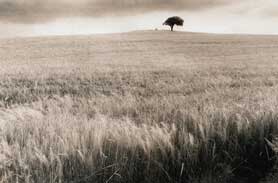
Fort Pierre Chouteau was a trading fort on the high Missouri
River plain in the grandest, boldest sense. The late 18th and early
19th centuries were robust and fascinating times in the upper Great
Plains. Wildlife, native tribes, and European traders, trappers, and
settlers lived and moved in large numbers on the Missouri -- early highway
to the new frontier.
In 1832 the American Fur Company built Fort Pierre Choteau after its
predecessor Fort Tecumseh (1822-1832) was dismantled due to the shifting
of the Missouri River. It was the largest fur trading post on the upper
Missouri River, and became the center of commerce and dominant European
settlement for the entire region.
George Catlin described the fort in 1832:
"This fort is undoubtedly one of the most important and productive
of the American Fur Company's posts, being in the center of the great
Sioux country, drawing from all quarters an immense and almost incredible
number of buffalo robes, which are carried to the New York and other
eastern markets and sold at a great profit."
An average 17,000 buffalo robes were traded each year at the fort for
guns, shot, powder, tobacco, blankets, cloth, sugar, salt, coffee, and
beads. Historic accounts indicate there were times when the fort was
surrounded by hundreds of Native American tepees. Settlement here helped
pave the way for major routes west, including the Bozeman and Oregon
Trails, and, of course, the historic Fort Pierre-Deadwood Trail.
The fort was used as a fur trading post until 1855, when it was sold
to the U.S. Army. The Army dismantled it two years later to build Fort
Randall, and today little remains of the above-ground structure of the
fort and associated buildings. Archaeological excavations each summer
by the State Historical Society, State Archaeological Research, SD Archaeological
Society, and the US Army Corps of Engineers. Volunteers are welcome.
The site has been designated as a national historic landmark.
Communities and Related Links
|